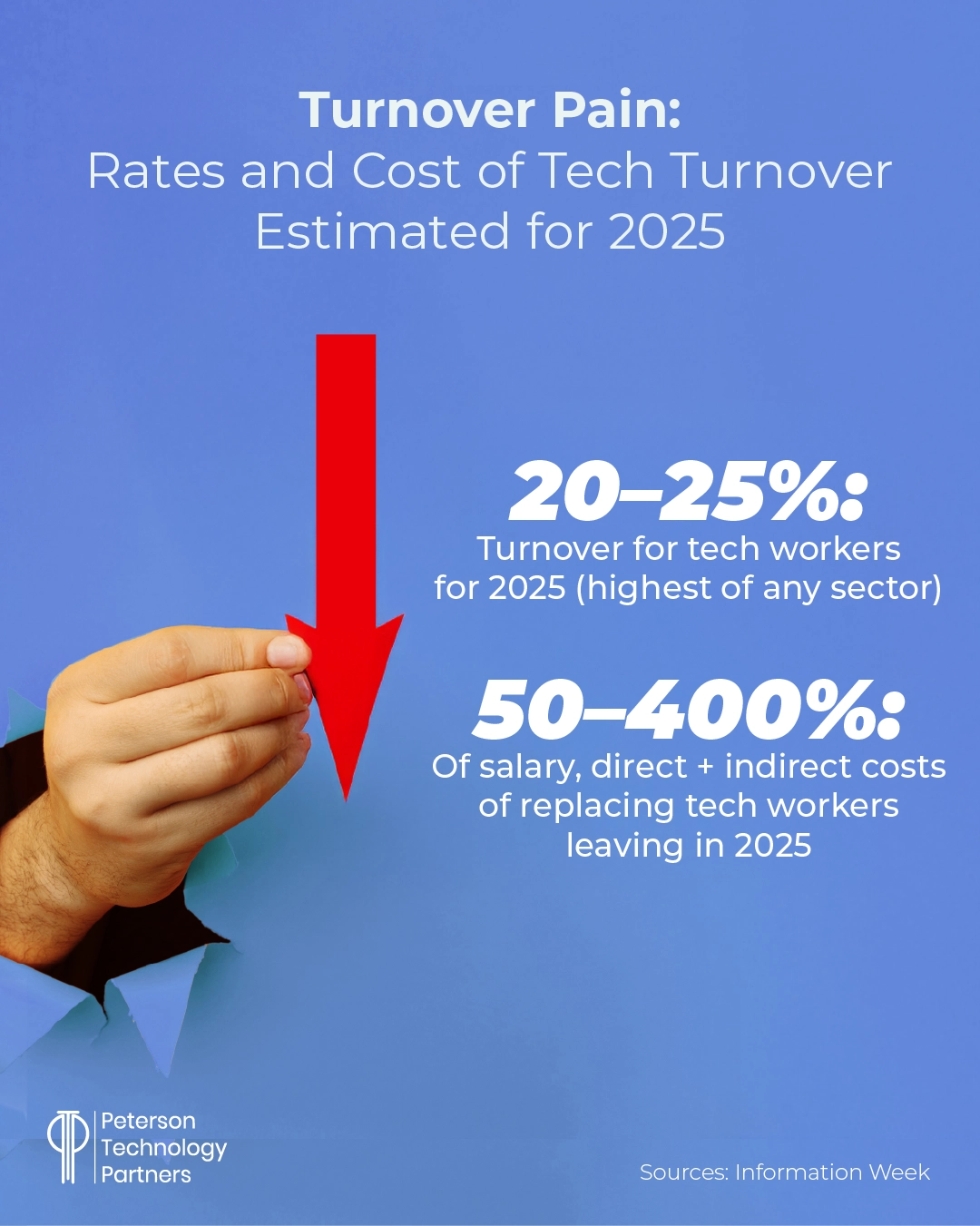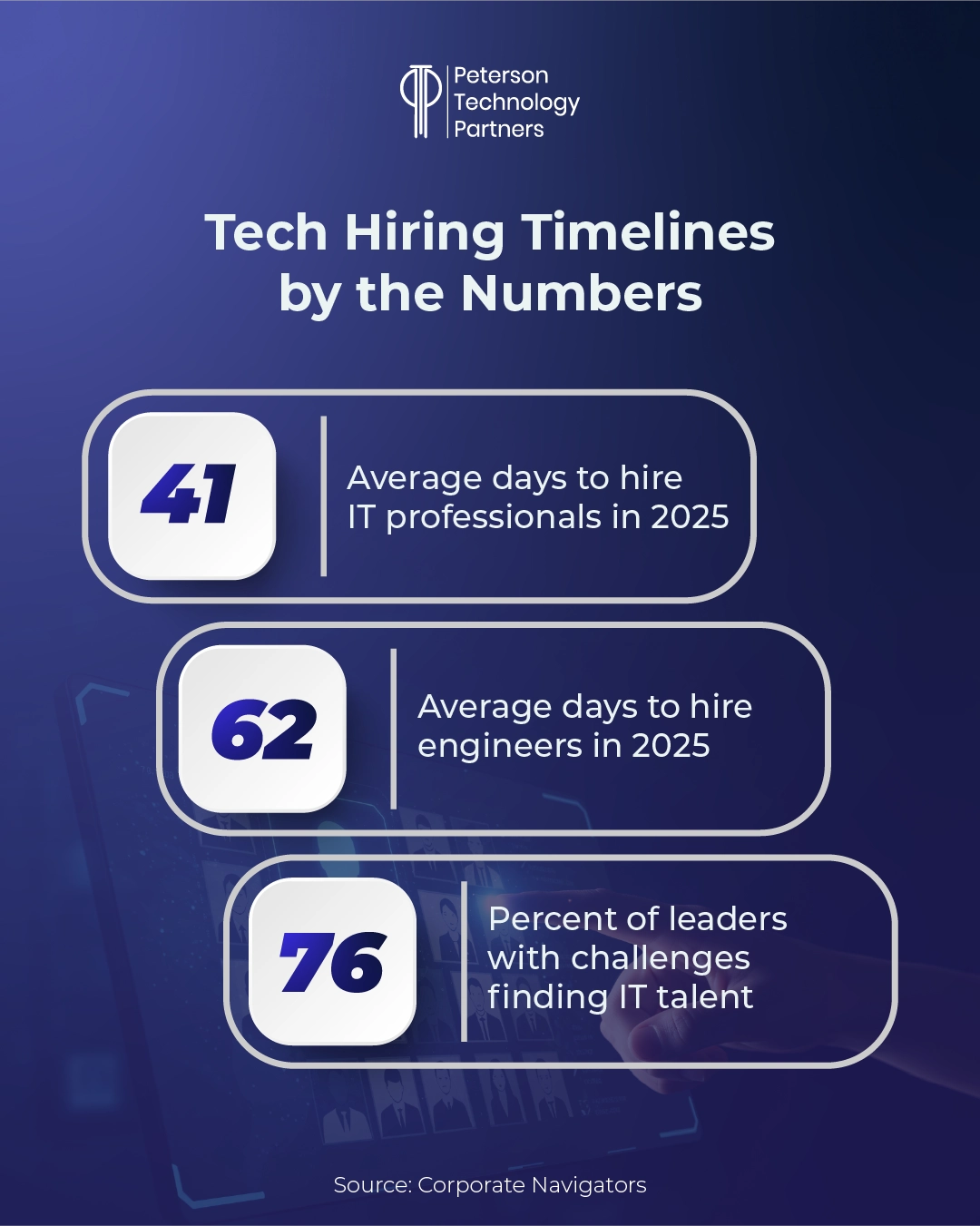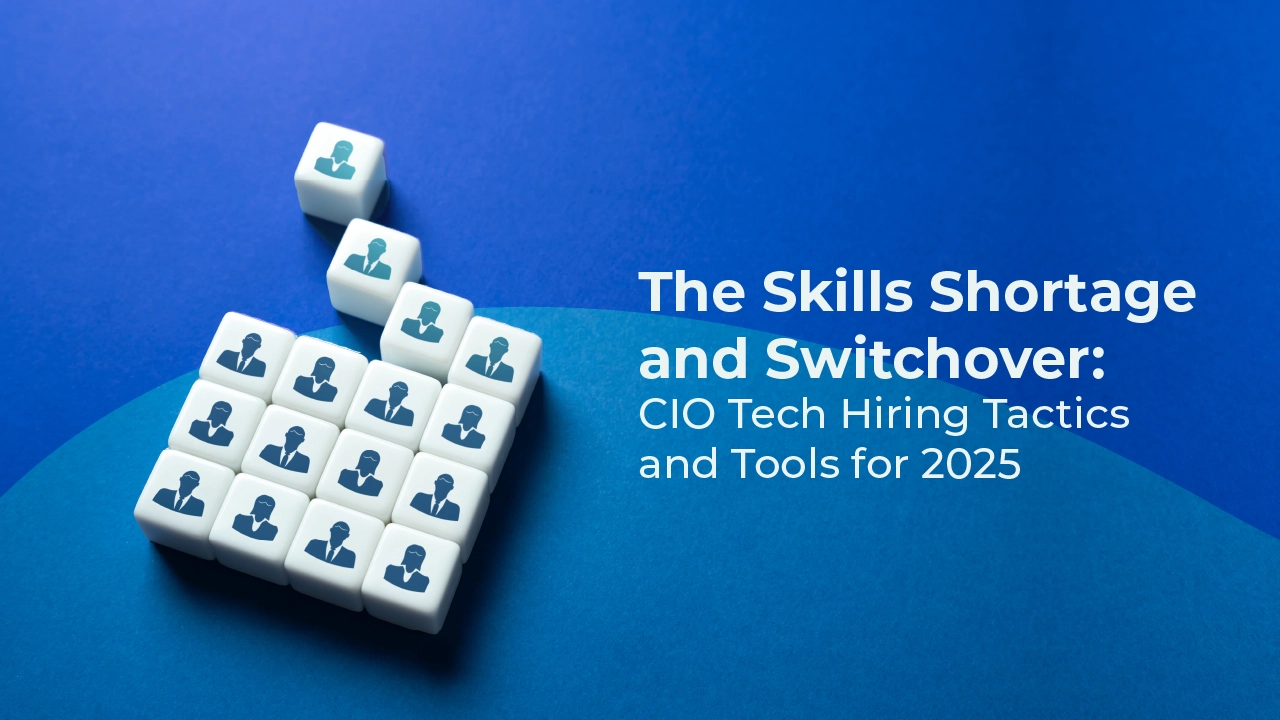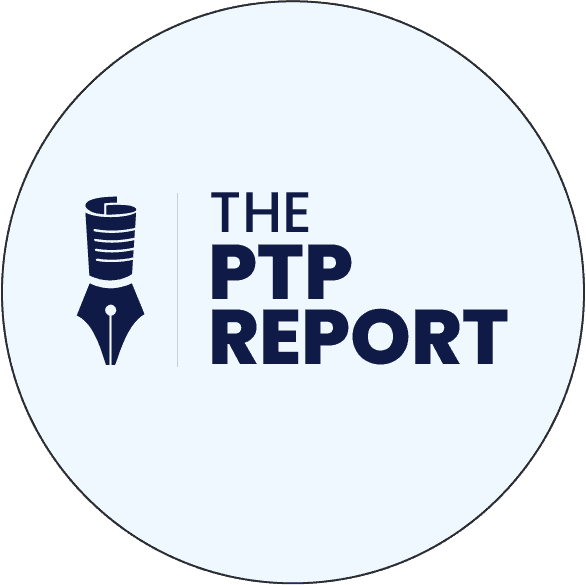Are you looking for experienced, quality IT talent in AI? How about cybersecurity, the cloud, or data analytics?
Does your company have a gap between the skills you need and the candidates you’re interviewing?
If any of this rings true, you’re not alone. It’s a strange time in the tech market, with demand for hiring in key areas up, unemployment and available experience (for the price) low, a wait-and-see on inexperienced workers, and turnover high and rising.
It’s also a time of rapid transformation, with the pressure on to get the right people to implement, utilize, and govern AI-driven innovations, as the news is full of exorbitant prices being paid for the best talent.
All this together may feel like a challenge that’s hitting CIOs from all directions.
Today’s Tech Talent Acquisition Challenges Are Greater than Ever
The bind is visible in the numbers, even if it’s not evenly distributed: Tech occupations are growing in key areas fast (US Bureau of Labor Statistics has the workforce exceeding 7 million by 2034), while the US supply isn’t keeping pace.
Widening the focus globally, some 90% of organizations are expected to be dealing with IT skills shortages as early as 2026, and per the IDC in 2024, the resulting combination of delays, quality issues, and revenue loss will amount to some $5.5 trillion.
That’s an absurdly large number, notably in the ballpark of McKinsey’s estimated boost in corporate AI use cases ($4.4 trillion). (But in contrast, PwC, in Sizing the Prize, puts the total, global AI market potential at $15.7 trillion by the end of the decade.)
It’s also exacerbated by tech reductions and slowdowns in other areas, like those divulged by Goldman Sachs senior economist Joseph Briggs in a podcast first shared with CNBC last week.
In it, Briggs outlines a labor disruption he attributes to AI, with unemployment among 20–30-year-old tech professionals climbing three points since January. He believes firms are holding off on hiring junior tech staff while they implement AI, though the need for experienced workers remains as high as ever.
In software development, companies work to use more AI-generated code, with Alphabet and Microsoft both boasting that 30% or more of their new code on some projects is AI-written, while Salesforce CEO Marc Benioff attributes as much as 50% of his company’s work to AI.
But despite all these advances in innovation, experienced, quality human labor remains a constant need in critical areas.
The IT Skills Shortage in 2025: Contributing Factors
The most obvious skills gap force comes from AI, with 87% of leaders (who are planning on hiring) listing AI as a needed skill, and Robert Half reporting in 2025 that 44% of organizations already boost pay for AI and ML skills.
Exploding Demand in the Critical Areas
As we led with, demand is high in key areas of need, like AI, cybersecurity, cloud, and data science.
Powering this is the need for these positions running across sectors, from healthcare to finance to manufacturing to agriculture and food. With AI, such skills are no longer confined to tech, and AI proficiency overall is increasingly viewed as valuable across occupations.
Double-Digit Employee Turnover in the Tech Industry and Experience Drain
We’ve seen hot talent being chased aggressively at top AI firms (Meta most famously), with absurdly large pay packages and even startup acquisitions geared around getting the best and brightest talent more than the companies themselves.
And overall, turnover remains high—and rising—for companies in these areas of high need.
Tech already has the highest attrition rate among industries, with the exact amount varying by study and estimate (most peg at 13–18% from the past five years, with numbers predicted in the 20–25% range for 2025, per Information Week).
The causes are numerous but include the common practice of swapping companies to move up (with the allure of higher pay), burnout, and pursuing greater flexibility/change of responsibilities.
This hurts most when the losses are mid-level and up. Losing staff at these levels can also mean losing valuable experience and irreplaceable organizational knowledge, alongside the cost of delaying projects.

Inexperience and AI
We opened with Goldman Sach’s report on the stalling of entry-level tech hiring. This aligns with prior reporting by The New York Times and Axios, as well as LinkedIn research on the trend, appearing to support statements by industry leaders like Anthropic CEO Dario Amodei, who suggested around the time of Claude 4’s release that AI could soon wipe out half of all entry-level positions.
Amazon CEO Andy Jassy shared an internal letter outlining how he believed AI would provide numerous benefits to customers and bolster internal efficiencies (from warehousing to shipping to marketing to customer service), but that at the same meant a reduced global workforce at Amazon.
[PTP’s Founder and CEO looked at this trend of AI shrinking some tech jobs in a recent newsletter.]
With many AI-first companies looking to resolve workplace challenges with technology before adding staff, the budget for entry-level positions may also be tightened.
For CIOs, automation can alleviate some pressures, though it doesn’t yet help with the main problem—a lack of talented IT workers in areas of need. And reducing access to these young workers also restricts the talent pipeline, running the risk of only increasing the scarcity of mid-level and up talent in the years to come.
Reducing Tech Recruitment Time: The Tradeoffs
The combination of high turnover and delays in the time it takes to get new employees on the job can be a significant issue.

These timelines vary wildly, and when dealing with senior data analytics recruitment, for example—or the search for systems programmers, database administrators, or CISOs—they can stretch to months or even years.
With hot candidates often fielding multiple offers, the pressure is on to accelerate the timeline, which means increased costs and chances of mishire, along with reduced odds of good cultural fit.
AI is being used successfully to accelerate hiring timelines, though it comes with its own risks and associated costs (see below).
Soft Skills and the Specialization Paradox
As CIO at the Rayburn Electric Cooperative Chase Snuffer noted in an online interview:
“Too often, we encounter individuals who are highly specialized—strong in one vertical, such as cybersecurity or networking, but who lack exposure to integrated systems across a complex enterprise environment.”
Finding people who can adapt and succeed in a shifting environment can be a unique challenge to identifying those who thrive in highly segmented workplaces.
This is yet another Catch-22: the need for deep expertise but also cross-functional awareness, adaptability, and a capacity to work successfully in teams.
For smaller organizations without the luxury of depth, this is an even greater challenge.
AI in the Recruitment Process is Increasingly Necessary
Our CEO has written on the rising AI arms race in recruiting, with AI services offering not only resume assistance and keyword substitution, but also agentic services that find job openings and apply, in mass, on behalf of candidates.
This has led to a stunning spike in applications for in-demand roles, with The New York Times reporting that LinkedIn, for example, now gets 11,000 applications a minute (up 45% from a year ago), with a lot of chaff accompanying the wheat.
AI recruitment tools can provide a lot of relief—in filtering and matching as well as contacting applicants, scheduling, and taking on some screening.
A Look at AI Recruitment Tools
Some 87% of employers now use AI in recruiting, including 96% of US recruiters (like PTP), per reporting by Time and Demand Sage.
This includes enterprise talent clouds (like Workday), layers that plug into ATS systems (like Eightfold), conversational front ends (like Paradox), and assessment and interview systems (like HireVue).
Systems scan social media (like LinkedIn profiles) and code repositories like GitHub and filter and rank resumes matching for skills.
And some 45% of HR teams also now use AI chatbots for onboarding.
In fields from retail to finance, AI has also meant large reductions in time-to-hire, with amounts ranging anywhere from 60–80%.
At PTP, we’ve seen this firsthand, with AI recruiting tools improving time-to-hire for some customers by as much as 80%, with greatly reduced costs, as well.
But this isn’t a one-stop solution. The talent has to be available and affordable, and the systems need to be implemented correctly, with ongoing, quality human oversight.
At PTP, this has meant the continued need for our experienced recruiters, who, in addition to drawing on their knowledge of hiring, are also now trained to recognize common scams.
The Ironies in Using Automated Sourcing for Needed Tech Roles
AI draws from amassed human and hiring data which is, of course, biased. And when not used correctly, that can mean amplifying these biases and filtering out talent that doesn’t match expectations or widespread precedent.
The company Workday is currently involved in a class-action suit alleging its algorithms led to age discrimination, and given the scale of use, this could translate into a significant liability.
AI regulations coming at the US state level are also increasingly mandating transparency on decision-making, with AI use in hiring among the use cases being heavily considered.
Accelerating time-to-hire in this fashion can mean weeding out the very people you need, while drawing in candidates better at manipulating the system.
Ironically this may also may not be a viable solution for companies that are already desperate to get experienced AI talent to implement or vet AI solutions in the first place. In these cases, third-party providers may be the only option, though as McDonald’s recently learned, they must be highly vetted for both security and oversight.
Tech Hiring Strategies for 2025’s Challenges
The ideal can’t always be the answer when dealing with critical shortages, so the question can be where do you compromise first?
Practical Skills, Problem Solving, Attitude, and Skills-Based Hiring
Skills-based hiring has been the industry buzz for some time, putting the emphasis on prioritizing provable knowledge and experience over degrees or prior job titles.
Real-world code challenges, workplace simulations, and portfolio reviews help assess such practical skills, and this can widen your talent pool.
Referrals are another way of helping find talent that works within your culture and can help you find soft skills like communication and emotional intelligence.
A desire to learn and grow is critical but can also be a challenge to identify and measure. But by being willing to take on candidates with less experience or proven skills but with a track record of problem-solving, learning, and adapting can open the door to talent that can grow into the roles you need.
This can sometimes prove a better fit than highly skilled but less motivated workers who may never stop looking for their next roles.
But inexperience means an openness to mentoring and learning on the job.
Luckily this is also an area where AI can assist, as a proven leveler. In studies by the Harvard Business School and Boston Consulting Group, AI provided a 43% productivity gain for the least skilled, vs just 17% for the highest skilled.
Experience with AI and a willingness to experiment, coupled with a winning attitude and record of adaptability, can prove a surprisingly effective way to resolve many of these challenges.
Planning, Upskilling, and Ecosystem Partnerships
Of course, a great mindset can’t always overcome a lack of experience in critical areas.
For hiring in cybersecurity, for network specialists, or software engineers capable of working with challenging codebases, the need for confidence, technical knowledge, and experience is sometimes non-negotiable.
In these cases, your pipeline, vision, and effective partnerships take on greater necessity than ever.
Investing in career tracks and learning opportunities remains critical, ideally with senior staff committed to mentoring more junior workers to ensure their knowledge is shared. This can be a tougher lift for some, as they may not have the teaching skills or willingness. This makes those that do even more valuable in today’s marketplace.
Upskilling through mentorship helps keep your pipeline stocked, even with tightened budgets for junior hires and the challenge of finding quality workers with five or more years of experience.
Nearshore outsourcing can be a middle ground for some of these issues. It can mean greater talent availability and lower costs with closer time-zones and better cultural affinity.
Hiring from countries like Mexico, Brazil, Colombia, and Argentina is an increasingly popular option in the US, with domestic talent pools in key areas stretched thin.
PTP and Your Digital Transformation Hiring Challenges
Planning ahead is critical, and it helps to have a finger on the pulse of what skills are looking to rise in importance over the next 12–18 months vs those which are fading fast.
Considering automation and alternative hiring strategies—from contract-to-hire to offshore or nearshore outsourcing—along with upskilling and strategic planning that tracks time-to-fill, cost-to-hire, and retention trends helps you anticipate these challenges and avoid being blindsided or suffering from lengthy vacancies.
PTP, with nearly three decades providing quality staffing and consulting services, can help you on all of these fronts.
If you’re looking for a partner you can rely on, no matter the need, consider us for today’s tech hiring challenges.
References
AI is already impacting the labor market, starting with young tech workers, Goldman economist says, CNBC
Is Artificial Intelligence (AI) Stock Palantir Technologies in a Bubble? We Just Got Our Answer…, The Motley Fool
Message from CEO Andy Jassy: Some thoughts on Generative AI, Amazon
Is Your AI-First Strategy Causing More Problems Than It’s Solving?, Harvard Business Review
Should CIOs Start Hiring for Attitude? and CIOs’ Top Hiring Challenges Today, and How to Solve Them, Information Week
Employers Are Buried in A.I.-Generated Résumés, The New York Times DealBook
FAQs
With layoffs and news of entry-level hiring slowing, how can there also be tech talent shortages right now?
Bottom line: everyone needs the same people. The rising capability of AI systems means a growing demand for talent skilled at AI implementation and use, along with cloud, data analytics, and cybersecurity. This pairs with a reduced domestic supply and high turnover to drive up competition.
What AI recruiting tools can actually help with these problems?
It’s ironic that companies need talent to help implement AI, while AI can also help find and onboard this talent.
This has led to a demand for third-party providers, offering solutions that streamline sourcing, screening, interviewing, and onboarding and can also provide predictive analytics on your workforce. PTP uses these solutions in-house, in conjunction with our talented recruiters. Providers include companies like HireVue, Workday, Paradox, Eightfold, iCIMS, Pete&Gabi, SmartRecruiters, and more.
How can CIOs adapt to deal with current tech hiring issues?
Reskilling and in-house development are more important than ever, coupled with good strategic planning to anticipate needs with AI transformation, and effective partnerships. Balancing time-to-hire with cultural fit and adaptable solutions like contract-to-hire and nearshore can help fill gaps.





